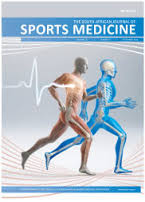Management of lumbar bone stress injury in cricket fast bowlers and other athletes
DOI:
https://doi.org/10.17159/2078-516X/2023/v35i1a15172Abstract
Background: Recent guidelines (including a special series in The Lancet) have emphasised a minimal role for imaging when assessing low back pain in adults, as the majority of patients will have non-specific findings on imaging that do not correlate well with pain.
Objective: To assess whether the diagnosis of lumbar bone stress injuries in young athletes should be considered an exception to the recommendation to avoid imaging for low back pain in adults.
Method: Narrative review.
Results: Early lumbar bone stress injury diagnosis has been available via traditional MRI sequences (and its precursor Single Photon Emission Computed Tomography (SPECT)) for 25-30 years. MRI assessments using bone window sequences (such as Volumetric Interpolated Breath-hold Examination (VIBE)) have allowed a better understanding of the diagnosis and prognosis of lumbar bone stress injury in young athletes. MRI with bone sequences has allowed non-radiating scans to serially follow the healing of unilateral stress fractures. In the majority of cases, non-chronic unilateral fractures can heal; however, this takes three-six months rather than the six-ten weeks that would be the typical unloading period if using symptoms (only) as a guide. The use of MRI to provide evidence of bony healing (as opposed to fibrous union, which creates the pars defect that predisposes to further bone stress lesions) can lead to better long-term outcomes in athletes. There is evidence to flag this as a structural lesion which is both painful and, more importantly, can heal/resolve if managed correctly. Therefore it represents an important ‘specific’ diagnostic subset within adult low back pain.
Conclusion: Structural (rather than functional) management of bone stress injuries in high-demand athletes, such as cricket pace bowlers, is in contrast to the recommendation of functional management for general back pain in adults. Structural management is justified when there are demonstrable superior outcomes of having better structure. Although this has not yet been shown in randomised trials of elite athletes, apparent lengthier Test cricket careers of pace bowlers who do not have pars defects suggest better athletic outcomes if bony healing is achieved. For lower demand young adults, or athletes with established bilateral pars defects, functional management may be more pragmatic.
Downloads
Downloads
Published
Issue
Section
License
Copyright (c) 2023 South African Journal of Sports Medicine

This work is licensed under a Creative Commons Attribution 4.0 International License.
The South African Journal of Sports Medicine reserves copyright of the material published. The work is licensed under a Creative Commons Attribution 4.0 (CC BY 4.0) International License. Material submitted for publication in the South African Journal of Sports Medicine is accepted provided it has not been published elsewhere. The South African Journal of Sports Medicine does not hold itself responsible for statements made by the authors.
How to Cite
- Abstract 1709
- PDF 1246






.png)